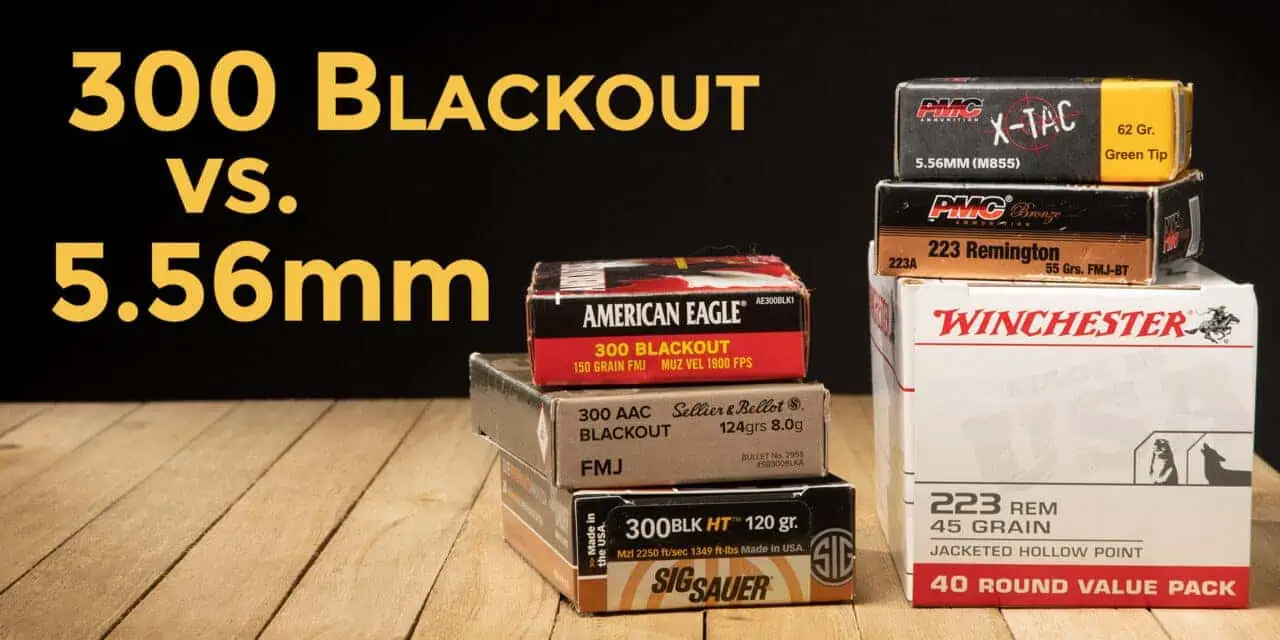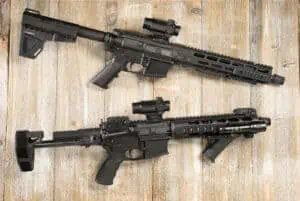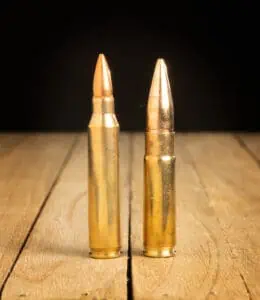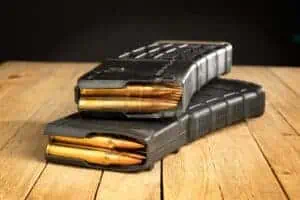AR Platform All Stars: 300 Blackout vs 5.56mm
The 5.56x45mm NATO round is the reigning champion of western military rifle cartridges, and has been for at least the past few decades. It’s popular for a reason. It’s lightweight and small compared to full-size rifle cartridges, yet is accurate and powerful enough to get good hits out to 300 yard and beyond. The 5.56mm round packs enough punch to be effective on the battlefield and as a home defense round. It also has a staggering array of bullet loads available, from rounds well-suited to hunting to steel-tipped penetrators that can punch through light cover.
So why would we need a round like 300 Blackout? The answer lies with the American military’s elite units and a maverick gunmaker called Advanced Armament Corporation, otherwise known as AAC.
The Origins of 300 Blackout vs 5.56mm
The introduction of a lightweight and compact assault rifle which fired a small rifle cartridge and was capable of full automatic fire meant there was almost no need for submachine guns anymore.
Almost.
Assault rifles like the M16 were small and compact, but they were still longer than a submachine gun. The 5.56mm round is effective because it’s a lightweight cartridge (usually less than 77 grains) that zips along at 2500 or more feet per second. However, because that speedy bullet breaks the sound barrier all the way to the target, it causes a loud “Crack!” as it travels towards the target. All this means that 5.56mm is not that useful when used with a suppressor. A suppressor may help tame the muzzle blast, but that “crack” is obnoxiously loud and can tip off the bad guys that something is going on.
This left America’s special operations forces in a bit of quandary. Most of the troops in these outfits knew how to use the M16 and its slightly smaller cousin, the M4 carbine. However, the round isn’t really suitable for suppression, something of great importance to the special operations crowd. They also wanted a heavier, larger caliber bullet than the 5.56mm cartridge, and they wanted it to work with guns that looked like and felt like the ones they were already using.
Taming A Wildcat
This is where the mad geniuses at AAC enter our story. AAC already had a reputation for making top-notch suppressors. Working with Remington Defense, they took the pre-existing 300 Whisper cartridge and tweaked it so that it could reliably operate at supersonic velocities with lighter bullets and use heavier, subsonic ammunition when suppressors were called for, and thus, 300 Blackout was born.
There are a lot of similarities with 300 Blackout vs 5.56. Both can use the same magazine. Both are ideally suited to the M16, M4 and their civilian cousin, the AR-15 (albeit in different calibers). However, there are some differences with 300 Blackout vs 5.56. Let’s begin with the most obvious three, bullet diameter and bullet weight.
A 300 Blackout cartridge is, in essence, a reworked version of the earlier, non-standard 300 Whisper cartridge. 5.56mm, on the other hand, is based on the 223 Remington cartridge and shoots a .22 caliber bullet. 125 or 124 grains is a typical baseline bullet weight for 300 Blackout vs 5.56, which uses 55 grain bullets as a starting point.
On The Range: 300 Blackout vs 5.56mm
However, one of the big advantages of 300 Blackout vs 5.56 is also a potential problem. An AR-15 chambered in 300 Blackout uses many of the same components as an AR-15 chambered in 5.56mm, with one big exception: The barrel. This means you can, in theory, chamber a round of 300 Blackout in an AR that’s set up to shoot 5.56mm. Everything will work, right up to the point where you pull the trigger, at which point you’ll be trying to shove a 30 caliber bullet down a 22 caliber barrel. Guns have exploded because people tried to do this, with catastrophic results. If you own AR’s chambered in 300 Blackout and 5.56, make certain you don’t confuse the ammunition that you load in your gun, and then check it again.
We’ll do a simple chronograph test to see what other differences there might be between 300 Blackout vs 5.56mm. The guns we’ll use are two AR pistols, one with a 10.5 inch long barrel that’s chambered in 300 Blackout, and another with a 11.5 inch long barrel chambered in 5.56mm. We’ll shoot three different types of ammo through each gun and measure their muzzle velocities and muzzle energy in order to get some idea of what each round can do.
300 Blackout And 5.56mm Ammo Tested
| Caliber | Bullet Weight (grains) | Average Velocity (fps) | Average Muzzle Energy (ft/lbs) | |
|---|---|---|---|---|
| Winchester JHP | 5.56mm | 45 | 2866 | 789 |
| PMC M193 FMJ | 5.56mm | 55 | 2591 | 797 |
| PMC M855 | 5.56mm | 62 | 2732 | 1080 |
| Sig Sauer HT Elite | 300BLK | 120 | 2207 | 1302 |
| Sellier & Bellot FMJ | 300BLK | 124 | 2035 | 1105 |
| American Eagle FMJ | 300BLK | 150 | 1851 | 1124 |
The muzzle velocity was higher for all the 5.56mm rounds, but the muzzle energy was higher for all the 300 Blackout rounds. However, this didn’t affect felt recoil at all. Both guns are easy to shoot and exhibit all the qualities that make AR pistols with pistol braces such a popular option for American gun owners.
The difference in muzzle energy also reflects how each round is meant to cause damage on the target. A 5.56mm round is meant to tumble over and over when it hits, transferring its energy to the target and causing damage as it does so. A 300 Blackout round does become unstable and tumble when it hits a target, but not as much as 5.56mm. Instead, a 300 Blackout relies on bullet design and weight to slow down and dump energy into the target.
5.56mm Ballistics
| Distance (yds) | 0 | 50 | 100 | 150 | 200 | 250 | 300 |
|---|---|---|---|---|---|---|---|
| Bullet Speed (fps) | 2732 | 2582 | 2437 | 2296 | 2163 | 2031 | 1905 |
| Energy (ft/lbs) | 1028 ft/lbs | 918 | 818 | 726 | 644 | 568 | 500 |
| Vertical Corrections (in) | 2.00 | 0.00 | -0.68 | 0.12 | 2.52 | 6.83 | 13.26 |
300 Blackout Ballistics
| Distance (yds) | 0 | 50 | 100 | 150 | 200 | 250 | 300 |
|---|---|---|---|---|---|---|---|
| Bullet Speed (fps) | 1851.6 | 1762.3 | 1674.4 | 1594.1 | 1517,5 | 1443.4 | 1374/1 |
| Energy (ft/lbs) | 1034 ft/lbs | 1034 | 936 | 846 | 676 | 694 | 629 |
| Vertical Corrections (in) | 2.00 | 0.00 | 1.33 | 5.76 | 13.51 | 25.15 | 40.99 |
When comparing the long range accuracy of 300 Blackout vs 5.56mm, 5.56mm is the clear winner.Punching our numbers into a Strelok Pro ballistics calculator, 62gr M855 5.56mm ammunition drops about 2.5 inches when fired from our test gun. However, the 150gr FMJ 300 Blackout round drops over 13 inches at the same difference. It’s even more dramatic at 300 yards, with a 13 1/4 inch drop for 5.56mm versus over 40 inches for 300 Blackout. If you’re looking to reach out and touch something at longer ranges, better do it with 5.56 rather than 300 Blackout
300 Blackout vs 5.56mm: Which is Better
I’ll admit that I didn’t “get” 300 Blackout when it first became popular in the early 2010’s. I had a bunch of AR’s that were chambered in 5.56 which I enjoyed shooting. I could shoot out to 500 yards and beyond with those ARs: Why did I need something like 300 Blackout?
Then a few years later, I had a chance to shoot a suppressed 300 Blackout rifle shooting subsonic ammunition. The loudest part of operating that gun was the “clack” as the bolt carrier group was released, and I began to see how the 300 Blackout could be useful.
A few years after that, I took up hog hunting. While you can use 5.56mm for hog hunting, I prefer to use 300 Blackout because of the extra muzzle energy and added thump of the thirty caliber bullet.
Reach Out And Touch Something
There are some drawbacks with 300 Blackout vs 5.56mm. It’s a short range round. Hits out beyond 500 yards are at best theoretical with this cartridge. The cost per round of 300 Blackout is higher than 5.56mm. 5.56mm is one of the most common rounds on the planet, while the demand for 300 Blackout is much smaller. If you’re used to going to the range and practicing at length with your AR, or just want a general plinking and target round that’s also excellent for home defense, 5.56mm is probably the right choice.
If you’re looking to suppress your gun or need a little bit more extra muzzle energy than what 5.56mm gives you, take a good look at 300 Blackout. I’m never going to leave 5.56mm completely behind, but for me, I really like the flexibility and power I get from an AR that’s chambered in 300 Blackout, and it will always have a home in my gun safe.





